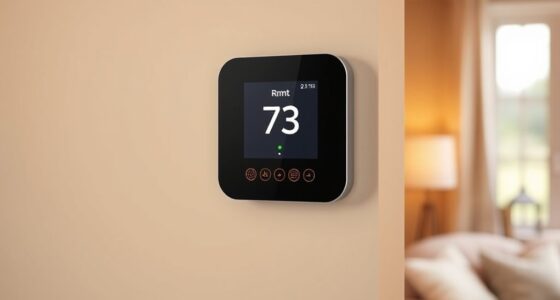If you’re looking to make your home more eco-friendly, I recommend exploring the top smart thermostats with sustainability certifications like ENERGY STAR. Models like the ecobee Smart Thermostat, Google Nest Learning Thermostat, and Honeywell T9 offer energy-saving features, remote control, and seamless compatibility with eco-conscious systems. These devices help reduce your energy use and lower bills while supporting green initiatives. Keep going, because there’s plenty more to help you choose the perfect smart thermostat for your home.
Key Takeaways
- ENERGY STAR certified models like Google Nest and Emerson Sensi Touch promote significant HVAC energy savings and eco-friendly operation.
- Thermostats with features like auto-scheduling, occupancy sensing, and geofencing optimize energy use and reduce waste.
- Compatibility with smart home ecosystems (Alexa, Google Assistant, Apple HomeKit) enhances seamless eco-friendly automation.
- Support for off-grid scheduling and remote control helps maintain comfort while minimizing energy consumption.
- Advanced monitoring and maintenance alerts contribute to long-term sustainability and efficient home energy management.
ecobee Smart Thermostat Essential – Wi-Fi Programmable Thermostat
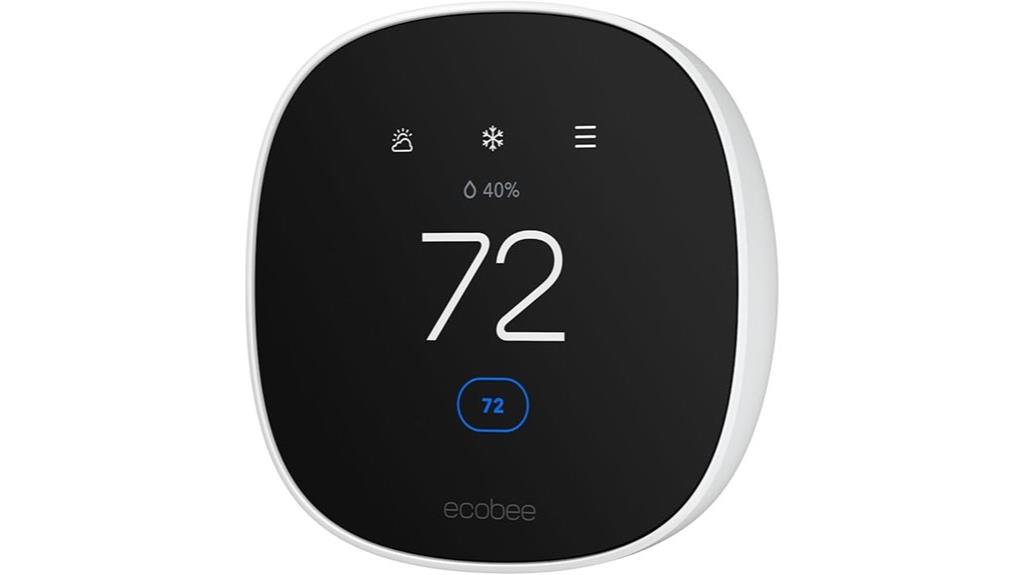
If you’re looking for an affordable, energy-efficient smart thermostat that’s easy to install and compatible with popular voice assistants, the ecobee Smart Thermostat Essential is an excellent choice. It’s Energy Star certified, helping you save up to 23% on energy bills, often paying for itself within six months. The device features a sleek LCD display, touch controls, and auto-scheduling, making home climate management simple. Compatible with Siri, Alexa, Google Assistant, and Apple HomeKit, it integrates seamlessly into your smart home. Installation is straightforward, especially for DIY enthusiasts, and its compact design fits discreetly into any space.
Best For: homeowners seeking an affordable, energy-efficient, and easy-to-install smart thermostat compatible with multiple voice assistants and smart home systems.
Pros:
- Energy Star certified, capable of saving up to 23% on utility bills
- User-friendly app with intuitive controls and scheduling features
- Compatible with popular voice assistants like Siri, Alexa, Google Assistant, and Apple HomeKit
Cons:
- Limited to one schedule per season, requiring manual adjustments for seasonal changes
- Scheduling intervals are restricted to 30-minute blocks, not customizable to minutes
- Basic features lacking advanced customization options, which may frustrate power users
ecobee Smart Thermostat Premium with Sensors

The ecobee Smart Thermostat Premium with Sensors stands out as an ideal choice for homeowners seeking both energy savings and advanced environmental monitoring. It can save up to 26% annually on heating and cooling costs and is ENERGY STAR certified. The included SmartSensor adjusts temperatures in key rooms, reducing hot and cold spots, while built-in air quality monitors alert you to poor air conditions and remind you to change filters. It also detects open doors and windows, pausing HVAC to save energy. With a sleek design, vibrant display, voice control options, and safety features like smoke detection, this thermostat offers a thorough, eco-friendly home solution.
Best For: homeowners seeking to maximize energy efficiency, enhance environmental monitoring, and integrate advanced safety and smart home features.
Pros:
- Saves up to 26% annually on heating and cooling costs, reducing energy bills.
- Built-in air quality monitor and SmartSensor optimize comfort and health.
- Compatible with most HVAC systems and offers voice control via Siri and Alexa.
Cons:
- Requires a subscription to the ecobee Smart Security plan for security features.
- Apple Home Hub needed for Siri voice control integration.
- Premium design and extensive features may come at a higher upfront cost.
ecobee Smart Thermostat Enhanced, Programmable Wi-Fi Thermostat

For homeowners seeking a smart thermostat that combines energy efficiency with seamless integration, the ecobee Smart Thermostat Enhanced stands out. It can save up to 26% annually on heating and cooling costs by automatically adjusting temperatures when you’re away and preconditioning your home before your arrival. It also uses humidity adjustments and SmartSensor technology to focus on key rooms for ideal comfort. Compatible with Siri, Alexa, Google Assistant, and most smart home platforms, you can control it remotely via the Ecobee app or voice commands. Easy to install, energy Star certified, and suitable for most HVAC systems, it’s a smart choice for eco-conscious homeowners.
Best For: homeowners seeking an energy-efficient, smart, and easily integrable thermostat for seamless climate control and cost savings.
Pros:
- Saves up to 26% annually on heating and cooling costs.
- Compatible with major smart home platforms like Siri, Alexa, and Google Assistant.
- Easy to install with a Power Extender Kit and suitable for most HVAC systems.
Cons:
- Requires Wi-Fi connection for remote features; limited functionality offline.
- Might be complex for users unfamiliar with smart home technology during setup.
- Additional SmartSensor purchase may be needed for room-specific temperature monitoring.
Amazon Smart Thermostat
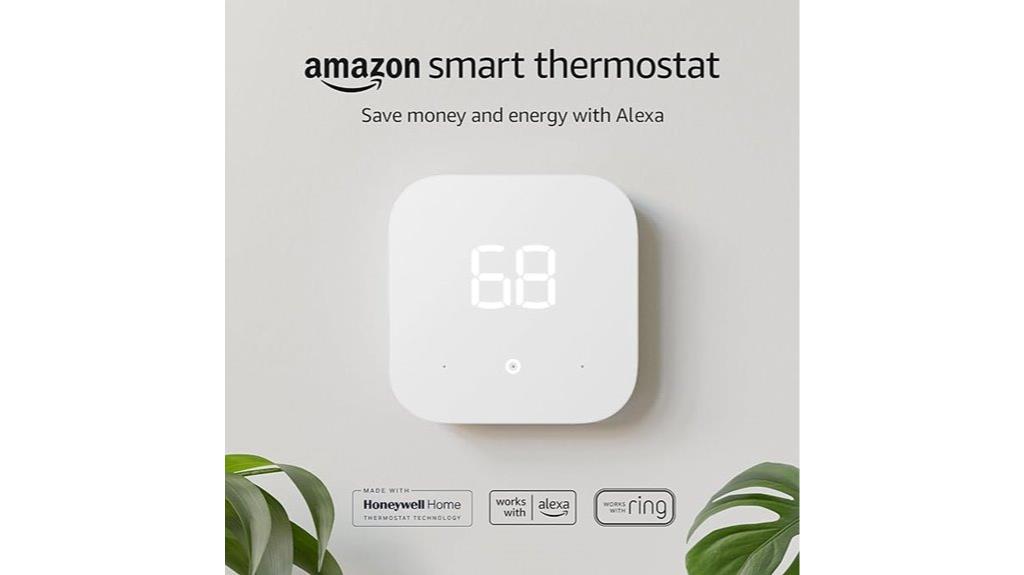
The Amazon Smart Thermostat is an excellent choice for homeowners seeking an easy upgrade to energy-efficient smart controls that seamlessly integrate with their existing Alexa and Ring devices. It supports C-wire installation and works with Echo devices like the Echo Dot (4th and 5th gen) and the Amazon Smart Air Quality Monitor, which can act as temperature sensors. The thermostat helps save roughly $50 annually on energy bills, according to EPA estimates, and Amazon provides information on local rebates. With Alexa’s voice control and remote access via the app, managing your home’s temperature becomes simple and convenient. Built with Honeywell technology, it’s a reliable, durable solution for smarter, greener living.
Best For: homeowners seeking an easy-to-install, energy-efficient smart thermostat that integrates seamlessly with Alexa and Ring devices for remote control and automation.
Pros:
- Supports C-wire installation for reliable connectivity.
- Compatible with popular Echo devices and temperature sensors for comprehensive smart home integration.
- Helps save approximately $50 annually on energy bills, with additional rebate information provided by Amazon.
Cons:
- Requires existing C-wire for optimal installation; homes without one may need additional wiring or adapters.
- Limited compatibility with older or non-Alexa-enabled smart home ecosystems.
- Installation guidance relies on the Alexa app, which may be challenging for some users unfamiliar with smart device setup.
Honeywell Home Smart Color Wi-Fi Thermostat
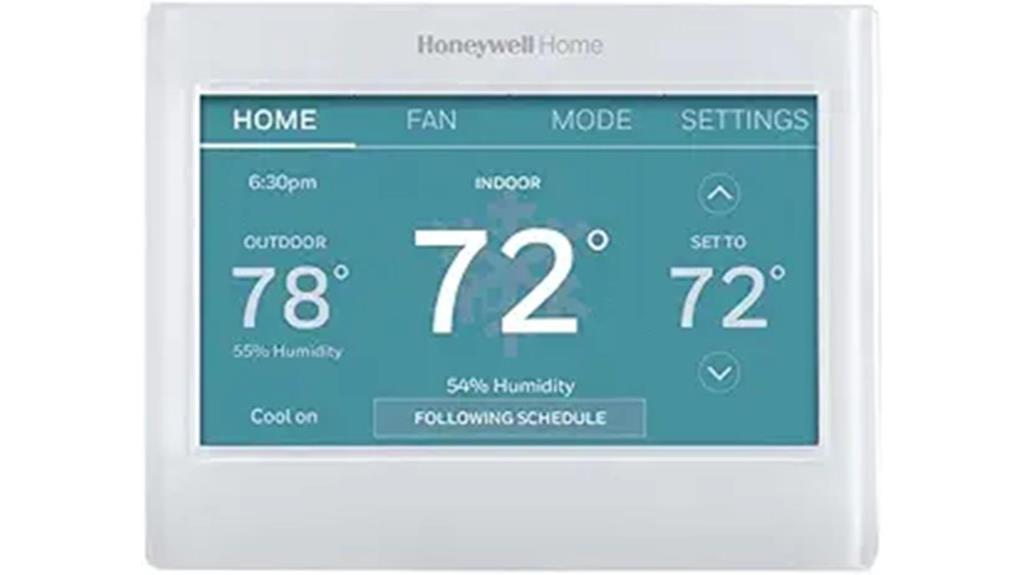
If you’re looking to reduce energy consumption while enjoying seamless smart home integration, the Honeywell Home Smart Color Wi-Fi Thermostat is an excellent choice. It’s ENERGY STAR certified, helping you cut down on energy use with personalized tips and the ability to participate in rebate and utility programs that may adjust your settings during peak times. You can control it remotely via app or voice assistants like Alexa and Google Assistant. Its customizable high-def color screen displays indoor/outdoor temps, humidity, and weather. Suitable for many heating systems, it requires a C-wire for installation. Overall, it combines efficiency, convenience, and smart features in one sleek package.
Best For: homeowners seeking to enhance energy efficiency and smart home integration with customizable control and remote access.
Pros:
- ENERGY STAR certified, reducing energy consumption and costs.
- Supports remote control via app and voice assistants like Alexa and Google Assistant.
- Customizable high-definition color display with real-time indoor/outdoor temperature and weather info.
Cons:
- Requires a C-wire for installation; may need a power adapter depending on existing wiring.
- Not compatible with electric baseboard heating or line voltage systems.
- Limited to forced air, hot water, steam, and heat pump systems with electric backup.
Sensi Lite Smart Thermostat

Looking for a smart thermostat that combines energy savings with easy installation? The Sensi Lite Smart Thermostat by Emerson is a great choice. It’s Energy Star certified, offers around 23% HVAC energy savings, and features a compact, simple design with an LCD display and backlight. Compatible with various systems like boilers, heat pumps, and air conditioners, it supports app control via Wi-Fi and works with Alexa, Google Assistant, and SmartThings. Installation is straightforward, with step-by-step instructions and minimal wiring needed. The thermostat’s scheduling, geofencing, and manual controls make it versatile and user-friendly, perfect for those seeking an eco-friendly upgrade without complex setup.
Best For: homeowners seeking an easy-to-install, energy-efficient smart thermostat compatible with a variety of HVAC systems and voice assistants.
Pros:
- Easy DIY installation with step-by-step instructions and minimal wiring needed
- Energy Star certified, providing around 23% HVAC energy savings
- Compatible with popular voice assistants like Alexa, Google Assistant, and SmartThings
Cons:
- Connectivity issues may occur after power outages or battery replacements, requiring troubleshooting
- Limited app analytics and scheduling flexibility for advanced users
- Not recommended for use outside US and Canada, and some users experience setup challenges
Google Nest Thermostat, Programmable WiFi Thermostat

For homeowners seeking an energy-efficient and eco-friendly smart thermostat, the Google Nest Thermostat stands out as an excellent choice. It’s ENERGY STAR certified, helping to lower energy use by automatically adjusting when you’re away. Supporting heating, cooling, and heat pump systems, it’s easy to install in about 30 minutes and connects seamlessly via Wi-Fi. You can control it remotely through the Google Home app or voice commands with Google Assistant or Alexa. Its learning capabilities optimize comfort and savings over time, while HVAC monitoring alerts you to potential issues. Its sleek design and compatibility with various systems make it a practical, eco-conscious upgrade for any smart home.
Best For: homeowners seeking an energy-efficient, easy-to-install smart thermostat that integrates seamlessly with their existing HVAC systems and smart home platforms.
Pros:
- ENERGY STAR certified, promoting energy savings and environmental benefits
- Supports remote control and voice commands via Google Assistant and Alexa
- Learning capabilities optimize comfort and reduce energy bills over time
Cons:
- Installation can be challenging for some users, especially with wiring and system compatibility
- Limited offline functionality; internet outages may affect operation and alerts
- Setup instructions are minimal, often requiring online tutorials or community support for troubleshooting
Emerson Sensi Touch Wi-Fi Smart Thermostat
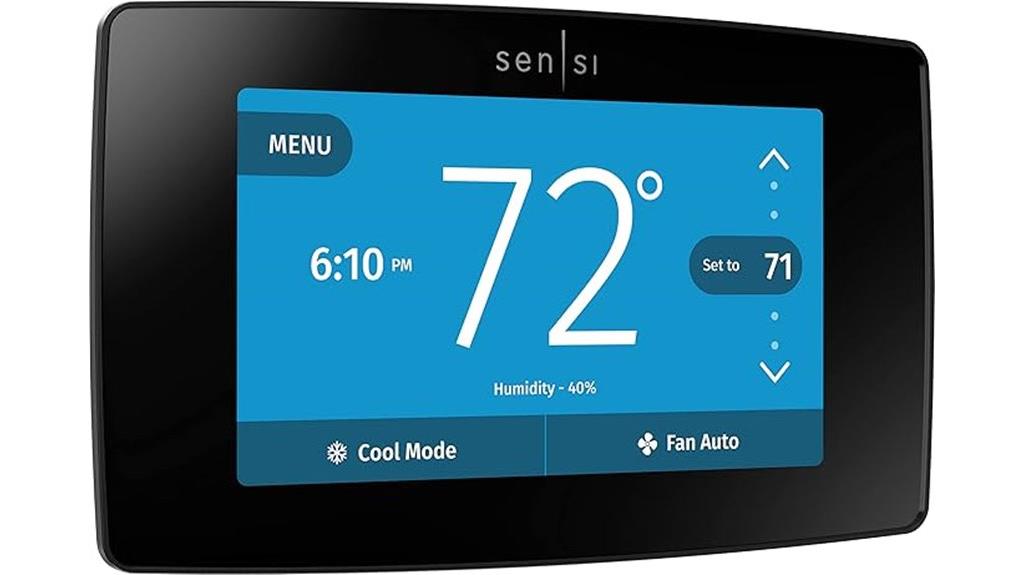
The Emerson Sensi Touch Wi-Fi Smart Thermostat stands out as an excellent choice for homeowners seeking energy efficiency and sustainability, thanks to its Energy Star certification. It features a large 4.3-inch color touchscreen and sleek design, available in multiple colors. With flexible scheduling, remote control, and detailed usage reports, it can help cut HVAC energy use by about 23%. Compatibility with voice assistants like Alexa, Google, and Apple, along with easy DIY installation, makes it practical. Its advanced features, including filter alerts and geofence technology, support ideal system performance, making it a smart, eco-friendly addition to any home aiming for sustainability.
Best For: homeowners seeking an energy-efficient, easy-to-install smart thermostat with modern features and compatibility with popular voice assistants.
Pros:
- Large 4.3-inch color touchscreen with sleek modern design for easy readability and control
- Supports multiple control methods including app, voice commands, and manual touch for versatile operation
- Energy Star certified, helping users save approximately 23% on HVAC energy bills
Cons:
- Requires a C-wire for full functionality; battery-only operation is not supported
- Registration and remote control features may be limited or problematic outside North America, especially in EU regions
- Basic Apple HomeKit compatibility with some functionalities not fully supported outside the US and Canada
meross Smart Thermostat for Home
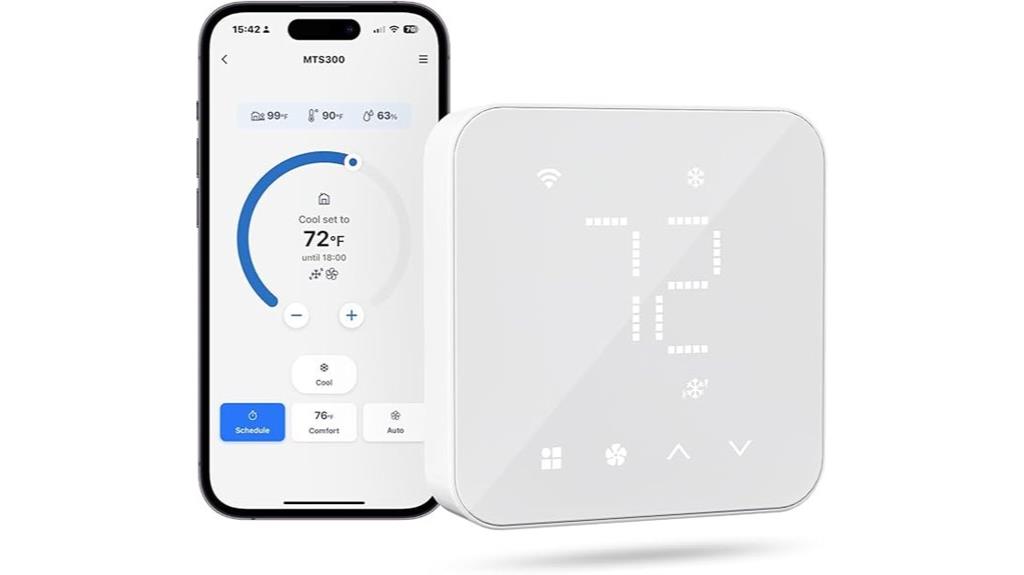
If you want a smart thermostat that easily integrates with most HVAC systems and offers reliable scheduling even without Wi-Fi, the meross Smart Thermostat for Home is an excellent choice. It works with 95% of HVAC setups, including conventional heating, cooling, and heat pumps, though it doesn’t support electric baseboard heaters. It requires a C-wire or a Meross adapter for installation. The thermostat supports 2.4GHz Wi-Fi and features customizable 7×24-hour schedules that run even when offline, ensuring consistent comfort. Plus, it supports Matter technology for seamless voice control via Apple, Amazon, Google, and Samsung platforms, and can be managed remotely through the app.
Best For: homeowners seeking a versatile, easy-to-integrate smart thermostat compatible with most HVAC systems and capable of offline scheduling.
Pros:
- Compatible with 95% of HVAC systems, including conventional heating, cooling, and heat pumps
- Supports customizable 7×24-hour schedules that operate even without Wi-Fi connection
- Seamless integration with voice assistants via Matter technology for local control
Cons:
- Not compatible with electric baseboard heaters
- Requires a C-wire or a Meross adapter for installation
- Limited to 2.4GHz Wi-Fi networks, not supporting 5GHz bands
Honeywell Home WiFi Smart Thermostat (RTH8800WF2022)
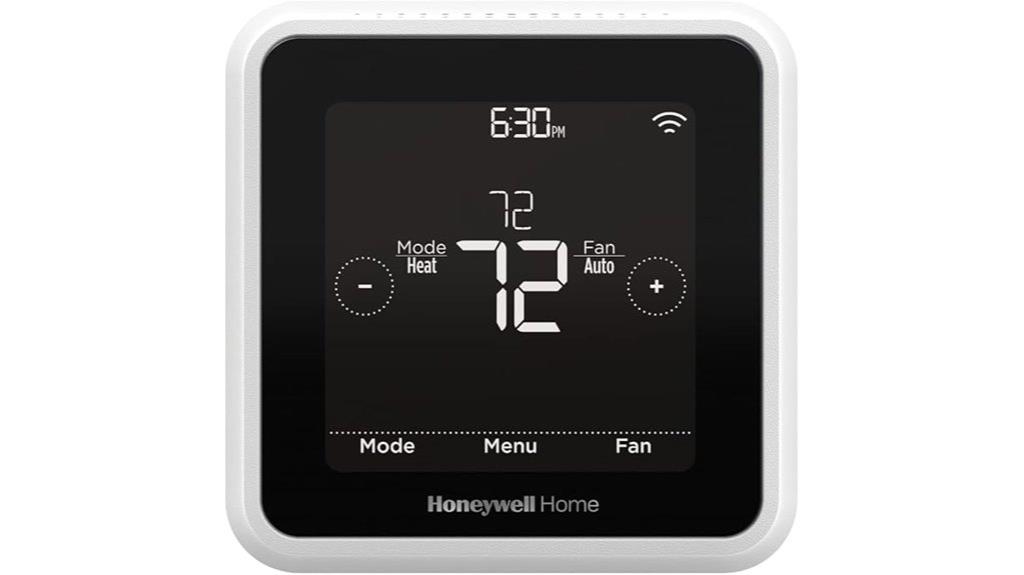
The Honeywell Home WiFi Smart Thermostat (RTH8800WF2022) stands out as an excellent choice for those seeking an energy-efficient solution that supports a variety of heating and cooling systems, including oil furnaces. Its 7-day programmable touchscreen and geofencing technology help optimize energy use, reducing bills by 8-16%. Certified by ENERGY STAR, it promotes sustainability and can integrate with Alexa for voice control. Keep in mind, a C-wire adapter may be needed for installation. By enabling auto home and away modes, it maintains comfort while minimizing energy consumption, making it a reliable, eco-friendly option for smarter home heating management.
Best For: homeowners seeking an energy-efficient, customizable, and smart heating solution compatible with various systems, including oil furnaces.
Pros:
- Supports multiple heating and cooling systems, including oil furnaces, with optional C-wire adapter.
- Features a user-friendly touchscreen, 7-day programmable schedule, and Alexa compatibility for voice control.
- ENERGY STAR certified, promoting energy savings and potential rebates through utility programs.
Cons:
- May require a C-wire adapter for proper installation, which could add to setup complexity.
- Not compatible with heating-only oil systems unless a C-wire is present.
- Some users might find geofencing and scheduling setup initially challenging without prior smart thermostat experience.
Google Nest Learning Thermostat (4th Gen, 2024) with Nest Temperature Sensor
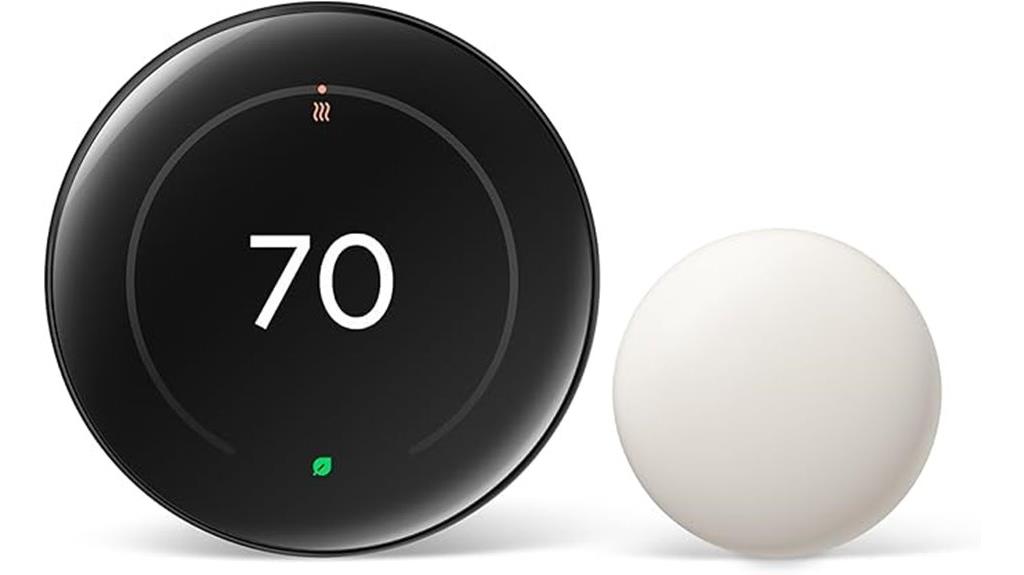
For homeowners seeking an energy-efficient thermostat that combines smart features with sustainability, the Google Nest Learning Thermostat (4th Gen, 2024) with Nest Temperature Sensor stands out. Its sleek Obsidian finish and larger display with Dynamic Farsight make it both stylish and functional. Easy to install and compatible with most 24V systems, it integrates seamlessly with Alexa, Apple HomeKit, and Google Assistant, plus Matter support. The thermostat learns your habits, suggesting schedule adjustments to cut energy use—saving up to 12% on heating and 15% on cooling. Using Nest Temperature Sensors, it manages hot and cold spots for consistent comfort, all while promoting energy savings.
Best For: homeowners seeking an energy-efficient, smart, and stylish thermostat that seamlessly integrates with various smart home ecosystems and optimizes comfort and savings.
Pros:
- Advanced learning capabilities that adapt to user habits to maximize energy savings
- Large, dynamic display with customizable clock or weather options for easy viewing from across the room
- Easy installation compatible with most 24V systems, often without needing a C wire
Cons:
- May require initial setup and calibration to fully optimize energy savings
- Premium design and features come at a higher price point compared to basic thermostats
- Dependence on Wi-Fi and smart home integrations could pose issues in areas with connectivity problems
Sensi Smart Thermostat
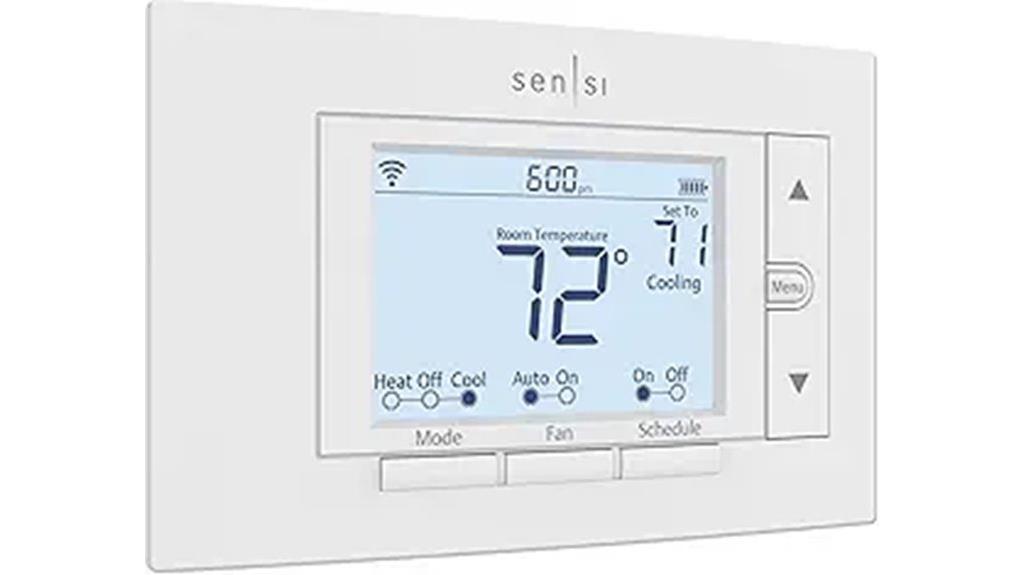
The Sensi Smart Thermostat stands out as an excellent choice for homeowners seeking easy installation and reliable energy savings, especially those who value sustainability. Its sleek design and DIY-friendly setup mean you can install it without patching or painting, fitting seamlessly into your home. Compatible with most HVAC systems, often without needing a c-wire, it offers Wi-Fi connectivity, voice control, and programmable scheduling. Certified by Energy Star, it helps save around 23% on energy bills. The intuitive app allows you to set schedules, monitor usage, and receive maintenance alerts, making it both eco-friendly and user-friendly.
Best For: homeowners seeking an easy-to-install, energy-efficient smart thermostat with reliable connectivity and user-friendly features.
Pros:
- DIY-friendly installation with step-by-step app guidance and hardware for quick setup
- Energy Star certified, helping save approximately 23% on HVAC energy bills
- Compatible with most HVAC systems, often without needing a c-wire
Cons:
- Limited detailed usage data and reporting features compared to higher-end models
- No support for Bixby voice control, only compatible with Alexa, Google Assistant, SmartThings, and Vera
- Occasional connectivity issues or difficulties adjusting settings for some users
Google Nest Learning Thermostat, 3rd Gen (2015)
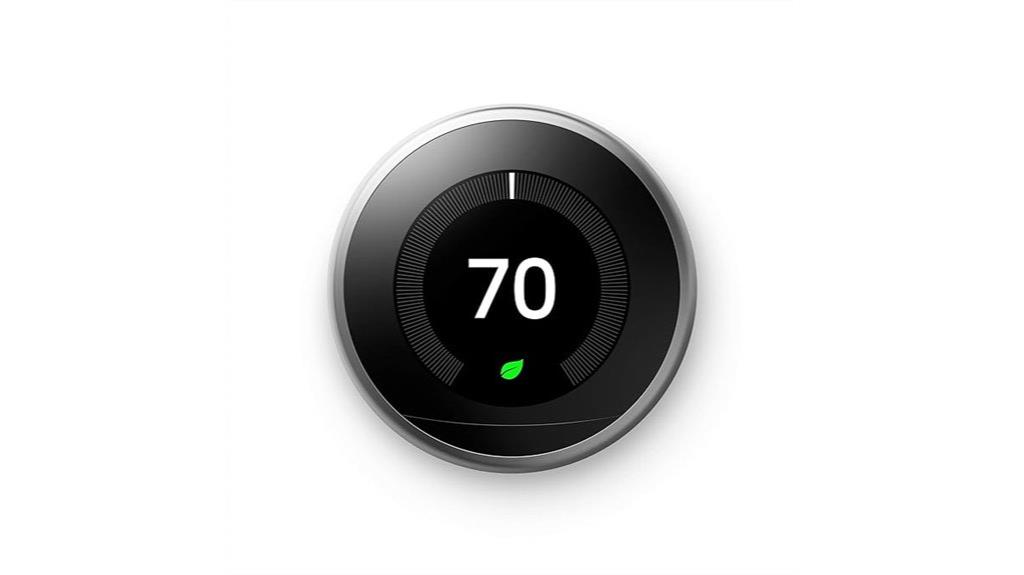
Are you looking for a smart thermostat that not only learns your preferences but also helps you save energy effortlessly? The Google Nest Learning Thermostat, 3rd Gen (2015), fits the bill perfectly. It automatically creates an energy-efficient schedule based on your habits and shows your energy usage history. The Nest Leaf encourages eco-friendly temperature choices, while Home/Away Assist adjusts settings when you’re out, reducing waste. You can control it remotely via the Nest app, making management simple. Just remember to verify compatibility beforehand. This thermostat combines convenience with energy savings, making it a smart choice for an eco-friendly home.
Best For: homeowners seeking an energy-efficient, smart thermostat that learns their habits and can be controlled remotely for convenience.
Pros:
- Learns user preferences to automatically create personalized heating and cooling schedules
- Helps reduce energy consumption and lower utility bills with features like Home/Away Assist and energy history tracking
- Compatible with Alexa and controllable remotely via the Nest app for easy management from anywhere
Cons:
- Requires compatibility verification before purchase to ensure proper integration with existing systems
- May not support all HVAC systems or advanced features depending on setup
- The design and interface may be less modern compared to newer smart thermostat models
Honeywell Home T9 WiFi Smart Thermostat

If you’re looking to enhance your home’s energy efficiency with advanced control options, the Honeywell Home T9 WiFi Smart Thermostat stands out thanks to its compatibility with multiple smart home platforms and energy-saving features. It offers a touchscreen display, supports Amazon Alexa, Apple HomeKit, Google Assistant, and SmartThings, and works with various systems like forced air, hot water, steam, and heat pumps. With Smart Room Sensors, you can monitor and balance temperature across rooms. Its energy-saving tools include remote control, Auto Home/Away scheduling, and participation in utility rebate programs. Despite some setup quirks, it’s a versatile, eco-friendly choice for smarter, more efficient home heating and cooling.
Best For: homeowners seeking a versatile, energy-efficient smart thermostat compatible with multiple smart home platforms and multi-room sensors.
Pros:
- Supports a wide range of smart home integrations including Alexa, Apple HomeKit, Google Assistant, and SmartThings.
- Allows for multi-room control and balancing temperature with Smart Room Sensors.
- Offers energy-saving features like remote control, Auto Home/Away scheduling, and utility rebate participation.
Cons:
- High price point, often exceeding $300 with sensors included.
- Setup and installation can be challenging, especially for sensor placement and Wi-Fi connectivity issues.
- Limited detailed instructions for sensor installation and possible connectivity issues with 5GHz Wi-Fi networks.
Google Nest Learning Thermostat, 3rd Gen
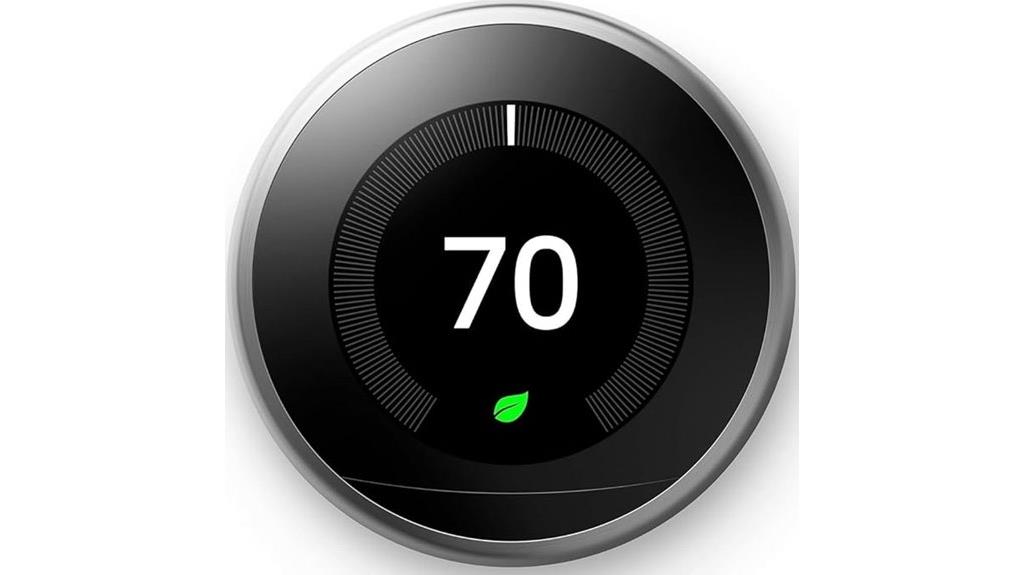
Anyone seeking a smart thermostat that seamlessly learns their schedule and adjusts to save energy will find the Google Nest Learning Thermostat, 3rd Gen, an excellent choice. It automatically adapts to your routines, optimizing comfort and efficiency. Features like Home/Away Assist switch to Eco Mode when you’re not home, preventing waste. You can review your energy use with Energy History and see the Nest Leaf indicator when saving energy. Plus, remote control lets you adjust settings from anywhere, and it’s compatible with voice assistants like Alexa. It also monitors HVAC performance, sending alerts for maintenance needs, helping prolong your system’s lifespan.
Best For: homeowners seeking a smart, energy-efficient thermostat that learns their habits and can be controlled remotely and via voice assistants.
Pros:
- Learns user schedules and adjusts automatically for optimal comfort and savings
- Compatible with voice assistants like Alexa for easy, hands-free control
- Monitors HVAC performance and provides maintenance alerts to prolong system lifespan
Cons:
- Requires Wi-Fi connection for remote features and updates
- Optional Nest Temperature Sensor sold separately for room-specific control
- Setup and configuration may be complex for some users new to smart thermostats
Factors to Consider When Choosing a Smart Thermostat With Sustainability Certification

When selecting a smart thermostat with a sustainability certification, I consider several key factors to guarantee it meets my needs. These include certification standards, compatibility with my existing system, energy-saving features, smart home integration, and how easy it is to install. Keeping these points in mind helps me choose a device that’s both effective and user-friendly.
Certification Standards
Choosing a smart thermostat with a sustainability certification requires understanding the standards behind these labels. Certifications like ENERGY STAR ensure the device meets strict energy efficiency criteria set by environmental agencies. These standards evaluate how well the thermostat reduces energy consumption, greenhouse gas emissions, and overall environmental impact. Certified thermostats typically feature functions like auto-scheduling, occupancy sensing, and remote management to support sustainability goals. Achieving certification involves rigorous testing and verification to confirm the device’s performance aligns with high environmental standards. By choosing a certified thermostat, you’re not only gaining an efficient device but also actively contributing to energy conservation efforts and lowering your carbon footprint. Understanding these certification standards helps you make a more informed, eco-conscious choice for your home.
Compatibility With Systems
Selecting a smart thermostat with a sustainability certification isn’t just about energy-saving features; it’s also important to guarantee it works seamlessly with your existing HVAC system. First, check that the device is compatible with your system’s voltage and type, whether it’s a 24V setup, heat pump, or electric baseboards. Make certain it supports the necessary wiring, including the presence of a C-wire or offers a power extender kit if needed. Compatibility with your smart home ecosystem—like Apple HomeKit, Google Assistant, or Amazon Alexa—is vital for smooth integration. Also, verify that it works with your specific heating and cooling equipment, such as furnaces, boilers, or multi-zone systems. Finally, review the manufacturer’s guidelines and online tools to confirm compatibility before making a purchase.
Energy Saving Features
Energy-saving features are the key reasons to opt for a smart thermostat with a sustainability certification, as they directly impact your home’s efficiency and your utility bills. These thermostats can cut HVAC energy use by up to 26%, saving you money while reducing environmental impact. Features like automatic occupancy detection, geofencing, and adaptive scheduling optimize temperature settings when you’re away or during peak times, preventing unnecessary energy use. Integration with utility demand response programs allows your thermostat to adjust during high-demand periods, often earning rebates or rewards. Additionally, monitoring system performance and offering maintenance alerts ensure your HVAC runs efficiently, avoiding waste caused by issues. Certified models also provide detailed usage reports and tips, helping you make smarter, eco-friendly decisions for your home.
Smart Home Integration
Integrating a smart thermostat into your existing home ecosystem enhances both convenience and efficiency, especially when it supports multiple smart home platforms. Compatibility with systems like Apple HomeKit, Google Assistant, Alexa, and SmartThings ensures seamless control and automation. Support for the Matter protocol allows devices to communicate directly, improving interoperability without relying solely on cloud services. Voice assistant integration makes adjusting settings quick and hands-free, boosting accessibility. Smart sensors and geofencing can work with other devices to optimize energy use based on occupancy and environmental data. Compatibility with home automation platforms also enables creating complex routines that adapt to your preferences and the home’s needs. Overall, a well-integrated thermostat helps streamline your home’s automation, making it more efficient and eco-friendly.
Installation Ease
Choosing a smart thermostat with sustainability certification can be straightforward when you focus on its installation features. Devices with clear, step-by-step instructions and minimal wiring requirements make DIY setup easy. Look for thermostats that include exhaustive mounting hardware, like built-in levels and wire labels, which simplify installation and reduce the need for professional help. Compatibility with common wiring configurations, such as C-wire support or power extender kits, also streamlines the process. User-friendly interfaces, along with detailed online guides or videos, can cut down setup time and troubleshooting. Many thermostats designed for quick installation can be set up within 30 to 60 minutes, even without specialized tools. This ease of installation helps you enjoy energy savings and sustainability benefits sooner.
Data Privacy Measures
Ever wondered how your smart thermostat protects your personal information while helping you save energy? It’s vital to choose a device that prioritizes privacy. Look for thermostats that clearly state they don’t sell or share your data with third parties. Check their privacy policies to see how they securely store and responsibly use your energy usage and occupancy data. Opt for models that offer local data processing or edge computing, which reduces reliance on cloud transfers and enhances privacy. Additionally, customizable privacy settings empower you to control what data is shared, anonymized, or kept private. Finally, consider whether the manufacturer participates in privacy certifications or audits—these indicate a commitment to robust data protection measures, giving you peace of mind while maintaining eco-friendly goals.
Frequently Asked Questions
How Do Smart Thermostats Contribute to Reducing Energy Consumption?
Smart thermostats help me cut down on energy use by learning my schedule and adjusting the temperature automatically. They optimize heating and cooling, so I don’t waste energy when I’m not home or sleeping. With remote control features, I can easily tweak settings from my phone. This intelligent adjustment reduces my utility bills and my home’s environmental impact, making my living space more eco-friendly and cost-efficient.
Are Sustainability Certifications Verified by Independent Organizations?
Imagine a certification badge glowing brighter than a lighthouse— that’s how verified their trustworthiness is! I’ve found that independent organizations rigorously evaluate sustainability claims, ensuring these certifications aren’t just fancy stickers. They check everything from energy efficiency to environmental impact, so you can confidently choose products that genuinely help the planet. Rest assured, these certifications are as real as the eco-friendly promises they proudly display!
Can Smart Thermostats Integrate With Renewable Energy Systems?
Absolutely, smart thermostats can integrate with renewable energy systems. I’ve seen models that connect seamlessly with solar panels or wind turbines, allowing me to optimize energy use and reduce my carbon footprint. By syncing with these systems, I can automatically adjust heating or cooling based on energy availability, making my home more eco-friendly and efficient. It’s a smart way to support renewable energy and save on utility bills at the same time.
What Are the Long-Term Cost Savings of Eco-Certified Thermostats?
They say, “A penny saved is a penny earned,” and eco-certified thermostats prove that true. Over time, I’ve seen significant savings on energy bills because these smart devices optimize heating and cooling. While the initial cost might seem high, the long-term savings from reduced energy use make up for it. Plus, they’re better for the environment, so it’s a win-win for your wallet and the planet.
Do Sustainable Smart Thermostats Require Special Maintenance or Upgrades?
You’re probably wondering if sustainable smart thermostats need special maintenance or upgrades. I’ve found that they generally don’t require anything too different from regular thermostats. However, it’s good to keep firmware updated and check sensors periodically to guarantee efficiency. Some eco-certified models might have specific filters or components that need occasional servicing, but overall, they’re quite easy to maintain, and upgrades are usually straightforward through app updates.
Conclusion
Choosing a smart thermostat with sustainability certifications is like planting a seed for a greener future. It’s a simple step that can make a big difference, helping you save energy and reduce your carbon footprint. Whether you go for the eco-friendly ecobee or the intuitive Nest, you’re making a choice that benefits both your home and the planet. Let’s turn our homes into eco-friendly havens—one smart thermostat at a time.




